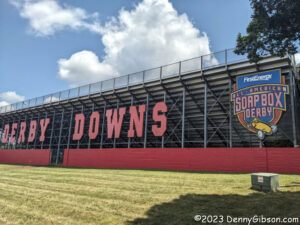 In the closing paragraph of my post on the Golf Manor Grand Prix, I mentioned that I probably wouldn’t make it to the Cincinnati Soapbox Derby qualifier but might attend the season finale in Akron, Ohio. As it turns out, both conjectures turned out to be accurate. I missed the Cincinnati event but made it to the big show for the first time ever.
In the closing paragraph of my post on the Golf Manor Grand Prix, I mentioned that I probably wouldn’t make it to the Cincinnati Soapbox Derby qualifier but might attend the season finale in Akron, Ohio. As it turns out, both conjectures turned out to be accurate. I missed the Cincinnati event but made it to the big show for the first time ever.
The very first All-American Soap Box Derby® took place in Dayton, Ohio, which is even closer to my home than Akron, but I did not attend. It was 1934. Things moved fast and the 1935 race was held on the streets of Akron with a permanent site, Derby Downs, being built by the next year. I was probably aware of the Derby as a child but it was not part of my world. I believe I first saw Soap Box racers in action within the last twenty years or so. By then, I was very much aware of the Derby and of just how big an event it was. More recently, I began to realize that if I was ever to witness what was an iconic happening in my home state I’d best be getting on with it.
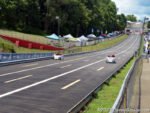
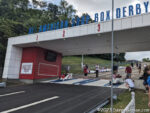 The opening photo was taken when I arrived on Friday. There seems to be something going on all week but Saturday is the big day and the only one that requires a ticket. Super Kids events were taking place when I was there Friday. This is a program that allows physically and mentally challenged children to participate by having a helper ride with them.
The opening photo was taken when I arrived on Friday. There seems to be something going on all week but Saturday is the big day and the only one that requires a ticket. Super Kids events were taking place when I was there Friday. This is a program that allows physically and mentally challenged children to participate by having a helper ride with them.
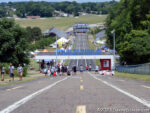
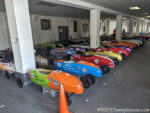
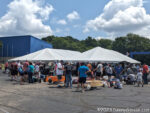 A golf cart shuttle took me all the way to the top where I could see lots of cars being readied to race and could get a really good look at the whole track too.
A golf cart shuttle took me all the way to the top where I could see lots of cars being readied to race and could get a really good look at the whole track too.
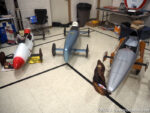

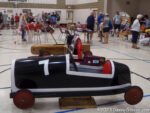 Here’s something I was not even aware of when I left home. I spotted an announcement about this Vintage Derby Car Show in my Facebook feed when I stopped in Columbus for breakfast. Because the poster and I had a bunch of mutual friends, I correctly guessed we had a Route 66-related connection. I stopped in after leaving the track and enjoyed looking over the displays, including a replica of the winner of that inaugural 1934 race, and meeting Facebook friend Keith Lamb in real life. Keith won the Derby in 1979 and had his car on display but, although we stood and talked beside it for quite a while, I failed to get a picture. I did better with Keith and his wife. This was the second year for the event with a repeat next year almost certain.
Here’s something I was not even aware of when I left home. I spotted an announcement about this Vintage Derby Car Show in my Facebook feed when I stopped in Columbus for breakfast. Because the poster and I had a bunch of mutual friends, I correctly guessed we had a Route 66-related connection. I stopped in after leaving the track and enjoyed looking over the displays, including a replica of the winner of that inaugural 1934 race, and meeting Facebook friend Keith Lamb in real life. Keith won the Derby in 1979 and had his car on display but, although we stood and talked beside it for quite a while, I failed to get a picture. I did better with Keith and his wife. This was the second year for the event with a repeat next year almost certain.
 Due to construction detours and bad planning (Mostly the latter.) I was late for opening ceremonies on Saturday. I could also try to blame the longer walk after parking. On Friday the field had just a few cars in a single row but was now almost full. I heard the national anthem as I neared the track and reached it just in time to see the Champions, who had apparently walked down the track as part of the ceremony, begin their walk up the track. The word “champion” was used a lot and in this case referred to all the competitors. In the act of qualifying for this event, each of them had become the champion of something.
Due to construction detours and bad planning (Mostly the latter.) I was late for opening ceremonies on Saturday. I could also try to blame the longer walk after parking. On Friday the field had just a few cars in a single row but was now almost full. I heard the national anthem as I neared the track and reached it just in time to see the Champions, who had apparently walked down the track as part of the ceremony, begin their walk up the track. The word “champion” was used a lot and in this case referred to all the competitors. In the act of qualifying for this event, each of them had become the champion of something.
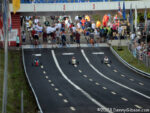

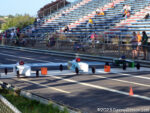 In rather short order, a full day of non-stop racing would commence. These three pictures show cars at the start, somewhere mid-track, and crossing the finish line. Notice that the racers are virtually side by side in all three pictures. This was typical. Winning margins of 0.005 and 0.006 seconds were common. At least two races I watched were decided by 0.001 seconds. One of the later races ended in a dead heat requiring a two-car runoff. The biggest differential I noted was barely over 0.16 seconds.
In rather short order, a full day of non-stop racing would commence. These three pictures show cars at the start, somewhere mid-track, and crossing the finish line. Notice that the racers are virtually side by side in all three pictures. This was typical. Winning margins of 0.005 and 0.006 seconds were common. At least two races I watched were decided by 0.001 seconds. One of the later races ended in a dead heat requiring a two-car runoff. The biggest differential I noted was barely over 0.16 seconds.
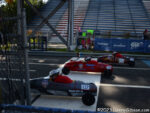
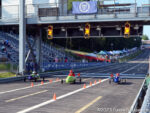 All the cars in the previous set of photos are Stock Division racers with drivers between 7 a 13 years of age and no more than approximately 5’3″ tall and 125 pounds in weight. Cars in this pair of photos are Super Stock Division racers with drivers between 9 and 18 years of age, up to about 6’0″ tall, and weighing up to about 150 pounds. Incidentally, the distance between racers in the second picture is just about as big as it gets.
All the cars in the previous set of photos are Stock Division racers with drivers between 7 a 13 years of age and no more than approximately 5’3″ tall and 125 pounds in weight. Cars in this pair of photos are Super Stock Division racers with drivers between 9 and 18 years of age, up to about 6’0″ tall, and weighing up to about 150 pounds. Incidentally, the distance between racers in the second picture is just about as big as it gets.
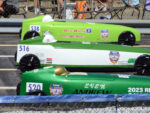
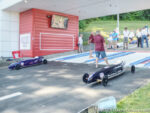
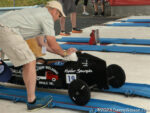 A third style of racer makes up the Masters Division. In these, the 10 to 20-year-old “more experienced” drivers essentially lay down in the cars with just the tops of their helmeted heads visible. Sometimes getting tucked in requires a little extra push from Dad.
A third style of racer makes up the Masters Division. In these, the 10 to 20-year-old “more experienced” drivers essentially lay down in the cars with just the tops of their helmeted heads visible. Sometimes getting tucked in requires a little extra push from Dad.
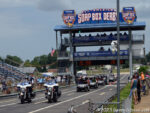
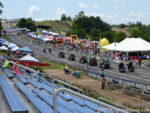 Racers qualify for the international competition either by winning the Local Race nearest to their home or by winning a Rally Regional Title by earning points in multiple races. Both methods produce champions in all three divisions. The bulk of Saturday’s racing involved eliminating all but nine competitors in each of these six groups. A victory parade celebrated each group of finalists.
Racers qualify for the international competition either by winning the Local Race nearest to their home or by winning a Rally Regional Title by earning points in multiple races. Both methods produce champions in all three divisions. The bulk of Saturday’s racing involved eliminating all but nine competitors in each of these six groups. A victory parade celebrated each group of finalists.
 Each of those six groups of nine was arbitrarily divided into three heats of three. The winner of each heat would run with the winners of the other two heats to decide 1st, 2nd, and 3rd. Second-place racers would compete for 4th, 5th, and 6th while third-place racers would compete for 7th, 8th, and 9th. The range of times for each heat usually looked something like this where barely 5/100 of a second separated all three cars.
Each of those six groups of nine was arbitrarily divided into three heats of three. The winner of each heat would run with the winners of the other two heats to decide 1st, 2nd, and 3rd. Second-place racers would compete for 4th, 5th, and 6th while third-place racers would compete for 7th, 8th, and 9th. The range of times for each heat usually looked something like this where barely 5/100 of a second separated all three cars.

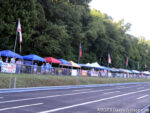
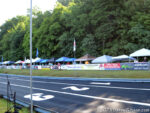 I was quite surprised by the nearly empty grandstandsbut eventually realized that unattached spectators like me were pretty scarce. Most people were there in support of a specific racer and had a home base established trackside. Of course, enthusiastic cowbell-equipped fans could be found anywhere.
I was quite surprised by the nearly empty grandstandsbut eventually realized that unattached spectators like me were pretty scarce. Most people were there in support of a specific racer and had a home base established trackside. Of course, enthusiastic cowbell-equipped fans could be found anywhere.
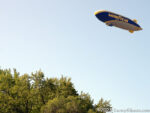

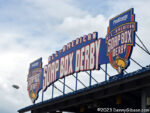 The Goodyear Blimp is hangared at an airport right beside Derby Downs so there would occasionally be things overhead to watch or be watched by and there was still plenty of action on the track but I had no one to root for. At the start of the day, I had identified two competitors from Cincinnati but both were eliminated in the first round. I then moved my support to a racer named Gibson. She made it to the final nine but when she lost her bid for first, I headed home. Great fun and I later learned that the Gibson kid won her last heat to earn a 4th place to bring honor to the family name.
The Goodyear Blimp is hangared at an airport right beside Derby Downs so there would occasionally be things overhead to watch or be watched by and there was still plenty of action on the track but I had no one to root for. At the start of the day, I had identified two competitors from Cincinnati but both were eliminated in the first round. I then moved my support to a racer named Gibson. She made it to the final nine but when she lost her bid for first, I headed home. Great fun and I later learned that the Gibson kid won her last heat to earn a 4th place to bring honor to the family name.

Pingback: At Speed in Cincy | Denny G's Road Trips Blog